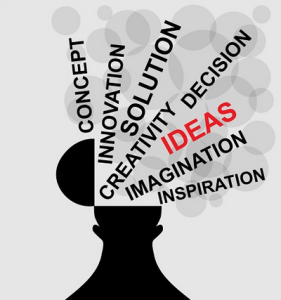Collaboration drives creativity because innovation always emerges from a series of sparks – never a single flash of insight. An awesome quote from D. Sawyer isn’t it? Success with building a creativity and innovation culture depends not only on coming up with great ideas and making them happen but also on establishing the culture with employees.

Innovation culture?
Check out our thoughts on building innovation.
It’s also important to recognize that culture comes from the people—it is the people. Think about the individuals within your organization—what are their personalities like?
Who are they outside of work? What tickles their fancy? All of these things lend to the culture of your organization, and ultimately your products and services.
We live in a business world accelerating at a dizzying speed and teeming with ruthless competition. As most of the tangible advantages of the past have become commoditized, creativity has become the currency of success.
One of the most often told stories about innovation is that of Alexander Fleming and his discovery of penicillin. Returning after a summer holiday in 1928, the solitary Scottish scientist noticed that a strange mold had contaminated the bacteria cultures he was growing. That single observation would change the world.
At least, that’s how the story is usually told. What really happened is that when Fleming published his findings, no one really noticed because what he discovered couldn’t have cured anyone. It wasn’t until a decade later that his paper was unearthed by another group of scientists who engineered it into the miracle cure we know today.
The truth is that the next big thing always starts out looking like nothing at all because it arrives out of context. Great innovations not only change the world, but the world also changes them and while that’s going on no one really knows how things will turn out.
A 2010 study of 1,500 CEOs indicated that leaders rank creativity as No. 1 leadership attribute needed for prosperity. It’s the one thing that can’t be outsourced; the one thing that’s the lifeblood of sustainable competitive advantage.
Unfortunately, most companies fail to unleash their most valuable resources: human creativity, imagination, and original thinking. They lack a systematic approach to building a culture of innovation and then wonder why they keep getting beaten to the punch.
Related post: Learn How to Think What No One Else Thinks
Creative culture and passion for innovation could become the main strengths of your company and the pillars of its long-term growth and success.
Here are some useful tips on how to convert virtually any company into a creative one.

Encourage curious, imaginative minds
We are big believers in curiosity and imagination. They contribute heavily to creative minds. We’re first curious about something, and it’s that curiosity that drives us to create.
Try to think of inventors who created something without first being curious or imaginative. Difficult isn’t it?
There was a study done recently wherein jazz musicians’ brains were monitored while they were improvising during gigs. Long, boring, tedious, academic story short — these musicians’ brains had essentially learned to “turn off” that little thing in there that tells you that this won’t work or will fail.
So without that stopping them, their imagination thrived, and you’ve heard many of the amazing results.
Innovation culture … foster creative learning
Creativity culture can be taught. There are many courses that teach people different creative techniques. Give your employees the opportunity to acquire skills that will help them become more productive and proficient in what they are doing.
“Culture isn’t just one aspect of the game,” Lou Gerstner wrote in the memoir of his historic turnaround at IBM, Who Says Elephants Can’t Dance? “It is the game. What does the culture reward and punish – individual achievement or team play, risk-taking or consensus building?” Culture is, in many ways, is how an enterprise reflects its mission.
Yet all too often, culture becomes an excuse for uniformity. Managers hire people like themselves and encourage their people to see things the same way, which can hinder a team’s ability to take on new ideas. On the other hand, studies have shown that diversity can create discord that can make it hard to get things done.
Clearly, we need to balance diversity with cohesion, but that not as easy as it would seem. It takes more than just putting people of diverse backgrounds and perspectives together and seeing what happens, you need a strategy to help them to work together. So while building a diverse team is a worthy goal, we need to put some thought into how to make it work.
Innovation culture examples … freedom of creative speech
People should be encouraged and inspired to openly and freely share ideas. There should be no censorship in the creative process… welcome everyone to contribute with their ideas, from the couriers and drivers to the top managers.
Create tribal communities and spirit
Your employees should feel members of one big family. They are the biggest assets of your business.
Creativity doesn’t often happen in a vacuum. As the author Steve Johnson says, chance favors the connected mind. When people are together, talking, laughing, thinking, exploring — they’re going to throw out ideas.
These ideas trigger something in someone else’s mind, and it snowballs. Before long, this group of folks has developed a creative solution that wouldn’t have been possible without the collective collaboration.
Don’t fall prey to the myth that only some people are creative and you’re not one of the chosen few. We are all creative; it’s just a matter of figuring out in what way.
So find things you’re curious about and that are interesting to you, use your imagination a little, stay motivated and work at it, and surround yourself with others who are doing the same.

Innovation culture characteristics … maximize diversity
Ziba, a top innovation-consulting firm in Portland, has an “Ambassador Program,” which allows employees to spend three months working in other disciplines, known as “tribes.”
During that time, the ambassador team member participates as part of those teams. This helps to create an understanding of another world. That diversity of thought and perspective, in turn, fuels creativity. It also translates to better business results.
Diversity in all its shapes, colors, and flavors helps build creative cultures. The diversity of people and thought; diversity of work experiences, religions, nationalities, hobbies, political beliefs, races, sexual preference, age, musical tastes, and even favorite sports teams.
The more diversity the better.
Foster Autonomy
We all prefer control over our environments. According to a 2008 study by Harvard University, there is a direct correlation between people who have the ability to call their own shots and the value of their creative output.
An employee who has to run every tiny detail by her boss for approval will quickly become numb to the creative process.
The act of creativity is one of self-expression. Granting autonomy involves extending trust. By definition, your team may make decisions you would have made differently.
The key is to provide a clear message of what results you are looking for or what problem you want the team to solve. From there, you need to extend trust and let them do their best work.
Innovation culture … fuel passion
Believe in what you preach. Give yourself 100% to the cause. Be honest if you want to be accepted. Lead by providing the example. Do not just lead – inspire!
Passion is the most essential ingredient for building a creative culture. Every great invention and every advance of humankind began with passion. A passion for change, for making the world a better place. A passion to contribute, to make a difference. A passion to discover something new.
With a team full of passion, you can accomplish just about anything. Without it, your employees become mere clock-punching automatons.
Start small
ITW is a diversified manufacturing company that produces a wide array of products from industrial packaging to power systems and electronics to food equipment to construction products.
It is a highly profitable company nearly 100 years old. Yet this big, old company, which is nestled in a traditional industry, thinks small.
The leaders at ITW believe that being nimble, hungry, and entrepreneurial are the ingredients for business success. As a result, any time a business unit reaches $200 million in revenue, the division “mutates” into two $100 million units.
Like an amoeba, the unit subdivides so it stays hungry and nimble.
The company would rather have 10 independently run an innovative $100 million units than a single, bureaucratic, and clunky $1 billion unit. Guess what? It’s working.
Companies that can stay more curious and nimble, have a better ability to change and adapt more easily. They have a stronger sense of urgency and are not afraid to embrace change. They put their curiosity, imagination, and creativity to work.
Gain motivated attitudes
Most of the time, you’ve got to want to be creative to be creative. You’ve got to work at being creative to be creative. I don’t feel that I’m terribly creative. Odd? Sure. Unique? Yeah, just like the rest.
But every once in a while someone will walk into my office, look around at the walls and ask how I came up with some of the ideas. Or we’ll be in a meeting and something will click for me as I’m scribbling in my little black notebook.
What most people don’t know is that I actually work on it. Yes and I actually practice. I think people think you’ve either got it or you don’t, but I think everyone’s creative in their own way.
So I started doing things to challenge myself to be creative. Sometimes they were business-related. Other times they weren’t.
And now I have an arsenal of things that I do on a regular basis to stretch my mind. It’s trying to make creative thinking and practice a consistent habit.
Encourage risk taking
Zappos as a company is known as much for its culture as for its innovative business model. The company has built a business that is growing rapidly by allowing individuals the freedom to take creative risks without that overwhelming sense of fear or judgment.
They tell their employees to Say what you think, even if it is controversial. Make tough decisions without agonizing excessively. Take smart risks. Question actions inconsistent with our values.
Another interesting example: A software company in Boston gives each team member two “corporate get-out-of-jail-free” cards each year. The cards allow the holder to take risks and suffer no repercussions for mistakes associated with them.
At annual reviews, leaders question their team members if the cards are not used. It is a great way to encourage risk-taking and experimentation.
Think this company comes up with amazing ideas? Absolutely.
18 Awesome Ways to Improve your Creative Thinking Skills

Comments
2 responses to “Innovation Culture Requires These 13 Ideas in Place”
Good one!! Now a days for marketing your website/tool/products you have to be creative and innovative at the same time. Make your marketing, advertising, campaigning goes easier and worth measuring with the help of various tools available at https://betapage.co/ check them out and make your business a big success.
Thank you.
Thanks for the feedback and sharing Richa.